UPDATE: I wrote a follow up here
So I recently did a pretty broad breakdown of stablecoins. When I was going back over it, I realized that I wanted to dive really deep into some of these and so I am going to start with Dai, and I am going to do it by going step by step through their whitepaper and giving my thoughts and potential problems with it.
First of all what is MakerDAO: it is the “Decentralized Autonomous Organization” that governs DAI.
What is DAI?: It is a soft pegged stablecoin.
What is a soft-pegged stable coin?: It is supposed to be near a certain value, but is allowed a degree of flexibility.
What is MKR?: MKR is a separate token used in the DAO to govern Dai and also to pay the “stability fee” which is the annual fee you pay to get your Dai.
Okay so that’s a lot of moving pieces, and as I have already discussed in my previous article there are issues in general with the concept of stablecoins. But without further ado let’s take a look at this whitepaper and see if there are any issues.

Okay, I can buy this so far, that’s a very fair opening argument.

Okay now we are starting to get into problems. It is going to be really hard for any collateral-backed cryptocurrency to keep a stable value relative to the US Dollar, unless the collateral backing it is the US Dollar. Otherwise we are going to be vulnerable to changes in the value of our collateral that are not reflected in changes in the value of the dollar. Also they never explain why it is necessary to realize the full potential of blockchain, but ignoring the grandiose marketing speak masquerading as technical language, we soldier on.

The issue here is appropriately incentivizing external actors. Namely it’s a really hard thing to do without accidentally introducing perverse incentives, but maybe they were able to do it.

First question, why would any in their right mind hold it for savings? Either directly hold your collateral or hold fiat. That is not a use case for a stablecoin. Also here we are bumping against an issue both I and the developers have acknowledged, we are not collateralizing with USD, but instead with Ethereum, and as the developers explained Ethereum is too volatile to be used as a currency, which means for this to work we are going to need to over-collateralize. Meaning if you want say $100 worth of Dai you will need to put up significantly more than $100 worth of Ether. Which makes it hard for me to figure out why someone is going to choose to do this.

So here we see where they say you need to have more collateral than Dai. They also say that you need to pay back an equivalent amount of Dai, and that is true, but what they have not explained yet is that you also need to pay a stability fee in MKR, their other token. Also they cannot always be collateralized in excess, because if there is a black swan event that destroys the value of Ethereum that is no longer true.
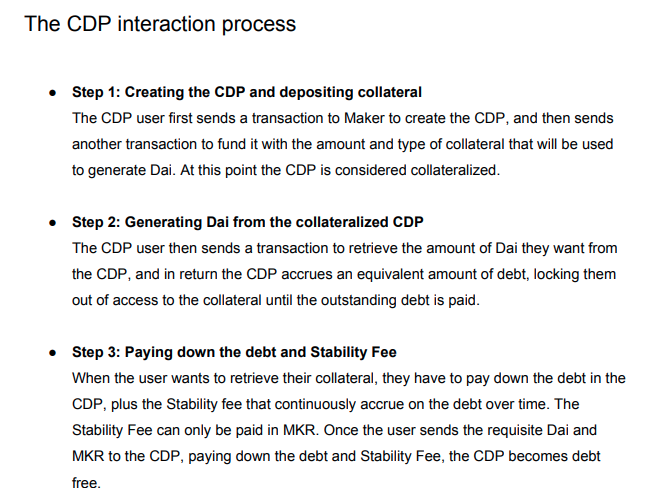
Here we finally get the mention of the “Stability Fee” which has to be paid in their MKR token.
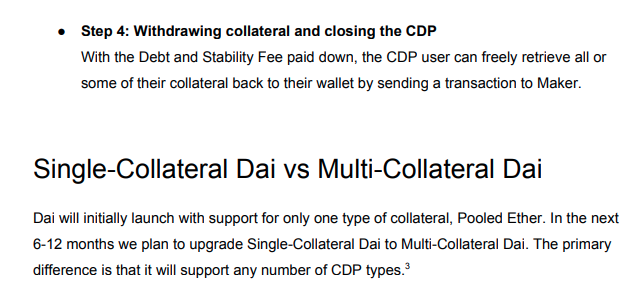
It’s been six months and they still have not launched Multi-Collateral Dai, but they do still have time so that is not a true criticism.

This is my favorite part of the entire whitepaper. So I have mentioned how even with the overcollateralization this is still very vulnerable to a black swan event that destroys the value of Ethereum. This part is where they say they in the event of this crash they will dilute the “Pooled Ether” which means that when you go to reclaim your Ether you will not even be receiving the full Ether you put in (if I’m understanding this right). Why someone would trust this, I do not know. The developers are obviously aware of this risk, but it seems to be ignored.

This is where we start to look at their incentives to determine whether they designed intelligently. These are just definitions so do not help us a ton. Just a warning this next part they try to obscure what they are doing with really technical language, but I am going to do my best to break it down.


So best as I can understand this section, when Dai falls below $1 what happens is that generation of new Dais becomes more expensive, meaning require greater collateral. They hope this restriction on new supply and the knowledge that presumably this should be worth about $1 means that there will also be increased demand below this point. Then when it breaks above $1 it now requires less collateral to generate Dais and presumably people are less likely to want them. My biggest fear here is in the case of a serious, say 40% 1 hour movement in the value of Ethereum. You are going to have people selling their Ether, possibly into Dai if it is trading in a pair, creating a strong demand driving the price of us, at this same time it is now easier to collateralize and create more Dais, but the value of the collateral is rapidly depreciating, thus leading to a greater likelihood of Dai becoming under-collateralized. If I am misunderstanding this mechanism however please reach out and help me.
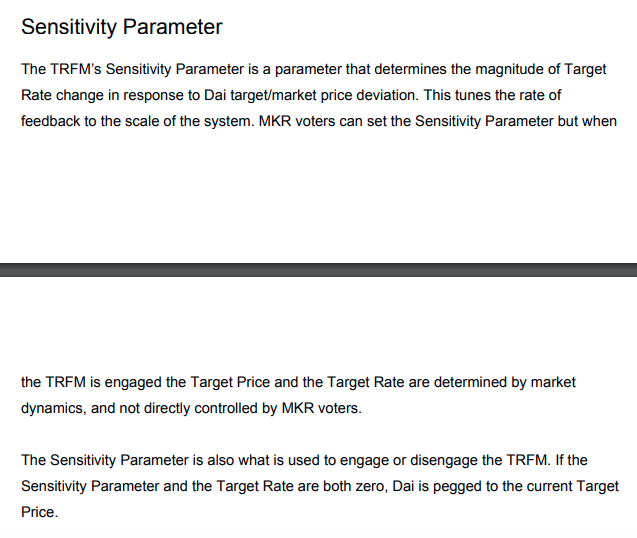
Intuitively, I feel like this is a value that is going to need to be set very careful, because otherwise I worry about appropriately capturing signal and noise.
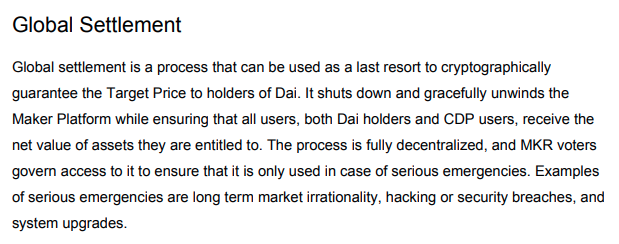
Now this is again where things get really interesting. Basically shuts down the whole system and gives them their share of the “pooled ether”. Problem with it? If it is being used there is a very good chance that Ether is now worth much less than your Dai was supposed to be. The term “long term market irrationality” to me feels like their hedge against the chance that crypto prices fall and they have no recourse.

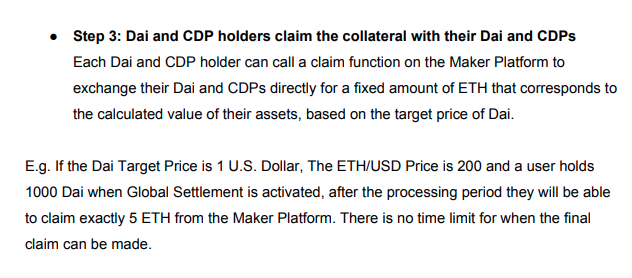
Basically saying what I said. This is the ripcord they pull when they are giving up because they are no longer collateralized.

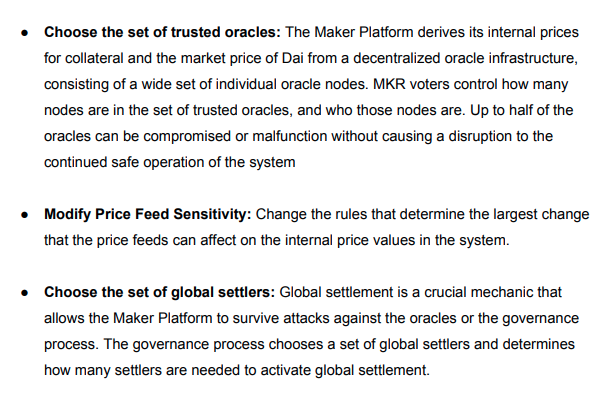
So now we are starting to get into the MKR token and what powers it gives in the DAO. We have already discussed some of these, but you can see how these are very important decisions.

The important thing here is the liquidation ratio. This will help us figure out how likely it is that the whole house of cards falls down.

So the stability fee like I have mentioned is the annual fee you pay for the privilege of having your collateral tied up by them. The penalty ratio is a little bit more confusing to me. As I understand it, if the value of your collateral gets to close to the value of your DAI it is automatically liquidated and then it used to buy up MKR when we have the multi-collateral system, but for now it looks like it burns the “Pooled Ether” which helps if it had to be diluted previously. This is honestly clever. I need to give props to this. If I am understanding it right it can help Dai survive pretty significant corrections, but I am dubious about a black swan event.

This part is endlessly fascinating to me. Apparently the plan with multiple assets is to sell off MKR whenever they become under-collateralized. The issue here is the legal issues with basically continuing ICO sales. Plus, I feel like this gums up the works economically, but I cannot put my finger on why yet. Best I can come up with is this: MKR is likely to be highly correlated to other crypto assets, the need for this dilution would arise in a situation wherein the value of MKR is already depressed due to a crypto crash, this market condition will require huge amounts of dilution to raise the funds necessary to recapitalize. It also makes it interesting, because it’s a constant downward pressure on the governance token, potentially making it easier for people to start influencing the DAO, but that of course depends on how the holding of MKR shakes out.

So first question how is every Ether backed CDP not a risky CDP? But basically as I understand it sometimes they will force liquidation of the underlying asset to preserve the value of the Dai. The issue here could be if enough sales are triggered simultaneously, and they are selling into thin liquidity.

Again look at the last paragraph here. Our biggest issue is going to be events where the market moves fast and suddenly. They’re going to get caught in some ugly dilution issues if I am reading it right. I’m gonna skip the section of the whitepaper on multi-debt auctions because it does not exist yet.

The keepers here are interesting. Many of them are bots that are meant to trade Dai to help it maintain it’s peg and sometimes they fail… as they did here https://twitter.com/prestonjbyrne/status/953769228238286848 so not exactly a foolproof tool.

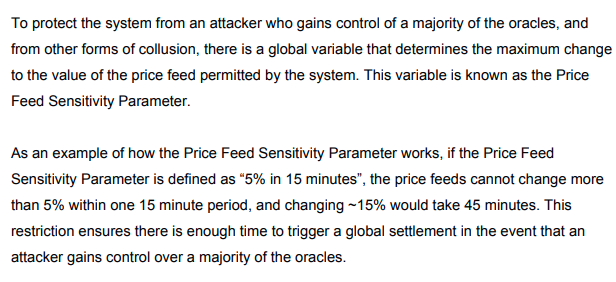
Pretty typical oracles. Some claim they represent an attack surface and they are right, but not an important one in my underinformed opinion. Some claim they aren’t truly decentralized, and that’s somewhat true, but sometimes you do not have a better option. I have no serious issue with them.

My biggest question here is about how many of these there will be, because this seems like a ton of power. The next section is examples of how to use it and we are gonna skip right over that. Section after that is called addressable market and is marketing bullshit so we are gonna skip that too. Then we get into the risks section and this is where I get excited.


All I have for this part is a reminder that a problem in a DAO smart-contract is the entire reason that Ethereum had to fork. $60 million stolen if I remember right. However, multiple security audits does seem reasonable.

Hey they are aware of my fears, do they have a solid solution though….

Nope….Next risk is competition which I do not care about so skipping.

Yes! We are finally to more of the problems and risks I have been pointing out. Namely they can only increase their liquidity so much to compensate, and they admit right here they need to maintain a large capital pool to feed the bots. You know what that sounds like to me? They’re gonna need more investment continually coming in to keep it working….

Better watch out for the SEC, and the CFTC, and the rest of the alphabet soup….
In conclusion, I still do not believe stablecoins are gonna be effectively created because unless they are backed by the asset they are pegged to and convertible there is always too much risk. This article was written in one night without editing, so please help me out in the comments if you find any errors.
If you would like to subscribe to my free newsletter then please go here.
If you want the posts from this blog delivered to your inbox:
I also have a Discord server that you can join here.
Thankyou 🙂
LikeLike
Thankyou 🙂
LikeLike
“and occasionally rising over 300% in a month.” << And falling 300% in a week 😉 they should state
LikeLike